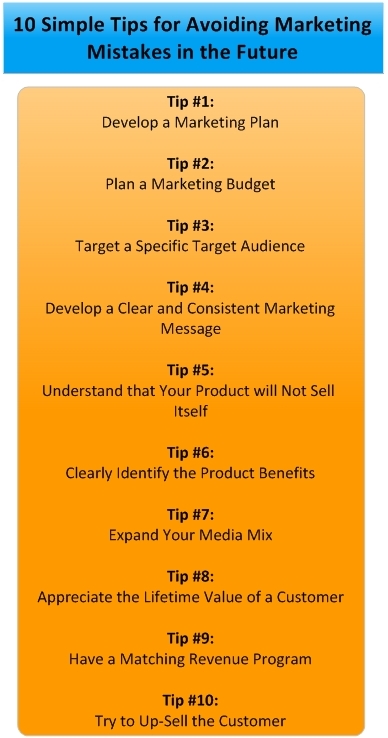 In early 2010 Patrick (of course I have changed his name) a friend who manages few companies was frustrated with some of the marketing outcomes. I promised to help Patrick clear his frustration but only if he poured me a nice glass of red. We discussed as how time and again novice marketers, even marketing veterans, make costly mistakes that result in poor performance of their marketing campaign. You don’t need me to tell you this, but common marketing mistakes can be avoided with adequate planning, attention to detail, and ongoing measurement and evaluation.
In early 2010 Patrick (of course I have changed his name) a friend who manages few companies was frustrated with some of the marketing outcomes. I promised to help Patrick clear his frustration but only if he poured me a nice glass of red. We discussed as how time and again novice marketers, even marketing veterans, make costly mistakes that result in poor performance of their marketing campaign. You don’t need me to tell you this, but common marketing mistakes can be avoided with adequate planning, attention to detail, and ongoing measurement and evaluation.
Personally I feel that marketing is critical to the success of every business. Unfortunately, many businesses discount the effect it can have, and they forego their marketing efforts for other activities. Or they make one or more of these mistakes, and their marketing efforts become ineffective.
After consuming few bottles of red Patrick and I came up with this list of 10 simple tips marketers should look at everyday. These simple tips an be applied to traditional marketing campaign, an Internet marketing campaign, or something that’s never been tried before.
With these 10 simple tips, you can market your business successfully and increase your bottom line.
Tip #1: Develop a Marketing Plan
A marketing plan is a critical part of every successful business. It helps you design your product and service to fill a market niche, identify your target audience, and then see what you need to do to get your target audience to buy your product or service. Also, when creating a marketing plan, you design the objectives and tactics to further develop your marketing efforts in the future.
Tip #2: Plan a Marketing Budget
You need to spend money to publicize, market, and advertise your product/business to make it successful. As a general rule of thumb, you may spend at least ten percent of your revenue on marketing efforts. Essentially, these costs keep your company going and your products selling. No matter what size your company, you need to have a marketing budget.
Tip #3: Target a Specific Target Audience
You need to understand that your market doesn’t include everyone. No matter what product you have, not everyone is going to want to buy it. So decide your target demographic and use appropriate media outlets to reach that audience. For example, if you have a diet product, you may target women ages 25 to 54, who are 10 pounds or more overweight. Then you need to advertise in women’s magazines or during women-oriented television and radio programs. Trying to appeal to everyone doesn’t work.
Tip #4: Develop a Clear and Consistent Marketing Message
All your marketing materials, advertisements, and promotions need to convey a consistent look and message. You want your target audience to know what you do or sell no matter where they see your name; you want to be recognizable. This helps you achieve more from your marketing budget because the message is reinforced throughout all the mediums you advertise in.
Tip #5: Understand that Your Product will Not Sell Itself
Many companies make the mistake of thinking that their product is so great and so different that they don’t need to market it at all. However, no one will know how great your product is, or that it even exists, if you don’t tell them. Word of mouth and referrals can only take you so far. No matter how great your product, you need to advertise and market to get it sold.
Tip #6: Clearly Identify the Product Benefits
The highly competitive marketplace is constantly changing and offering consumers more and more choices. For example, if you need laundry detergent, you have a whole aisle of different brands to choose from. So how do you base your decision? Something has to get your attention to make you choose one brand over another. And you need to create this differentiation in your product as well.
Defining the unique selling proposition for your product will help your target audience differentiate it from your competitors. Then work this uniqueness into your marketing plan and strategy to reach the specific audience who will buy your product.
Tip #7: Expand Your Media Mix
At one time, you could advertise on the three big television networks and reach 80 percent of the population. But now viewers have hundreds of different networks and channels to choose from just on television. Plus consumers can choose from satellite or cable television, print, radio, satellite radio, and the internet. Media today is very fragmented, so you need to reach your audience through more than one outlet.
Tip #8: Appreciate the Lifetime Value of a Customer
If you can earn a customer and keep him or her for life, then the value of that customer multiplies. For example, imagine you sell cars. If you have a customer who spends $10,000 a year to drive one of your cars, then over the lifetime of the relationship that customer will have given you $200,000. So what is it worth to earn that customer’s business? If you spend 10 percent, or $20,000, to get the customer’s business, you’ll earn a 10 to one return on your investment.
Tip #9: Have a Matching Revenue Program
A matching revenue program creates additional streams of income for your business. For example, if you sell someone a cosmetic product on television, a matching revenue would be to sign them up for a continuity program where you send them more of the product on a regular schedule and charge their credit card automatically. This type of program allows you to bring in additional revenue and maintain your customer relationships.
Tip #10: Try to Up-Sell the Customer
Up-selling means taking advantage of the sales opportunity and incremental revenue by adding additional or related products to a customer’s purchase. For example, adding fries to an order at a fast food restaurant or adding additional features, such as a sunroof on a car sale, are up-sells.
Marketing challenges are actually quite common among businesses of all sizes. In today’s competitive business world, many small and mid-sized companies lose sight of the marketing practices that made them successful in the first place. And even the large, established companies tend to let their good marketing practices slide sometimes. These tips are always in our minds, it’s not rocket science. Make sure you print this out and stick it over your computer.
Chintan is the Founder and Editor of Loyalty & Customers.






18 Trackbacks / Pingbacks
Comments are closed.